Political cartooning has been the most consistent form of public humour in Canada since the time of Confederation. In most of our major daily newspapers, and more recently online, cartoonists have churned out hundreds of thousands of satirical drawings, poking fun at all aspects of government. These cartoons are a record of Canadian political preoccupations, concerns — and even delights. The ones most likely to be remembered are those portraying our prime ministers.
John A. Macdonald: Cartoon favourite
Cartoonists in the modern era will sometimes include in their work a caricature of Sir John A. Macdonald (prime minister 1867-73, 1878-91) – even today our most recognizable prime minister – in order to make parallel points with contemporary events.
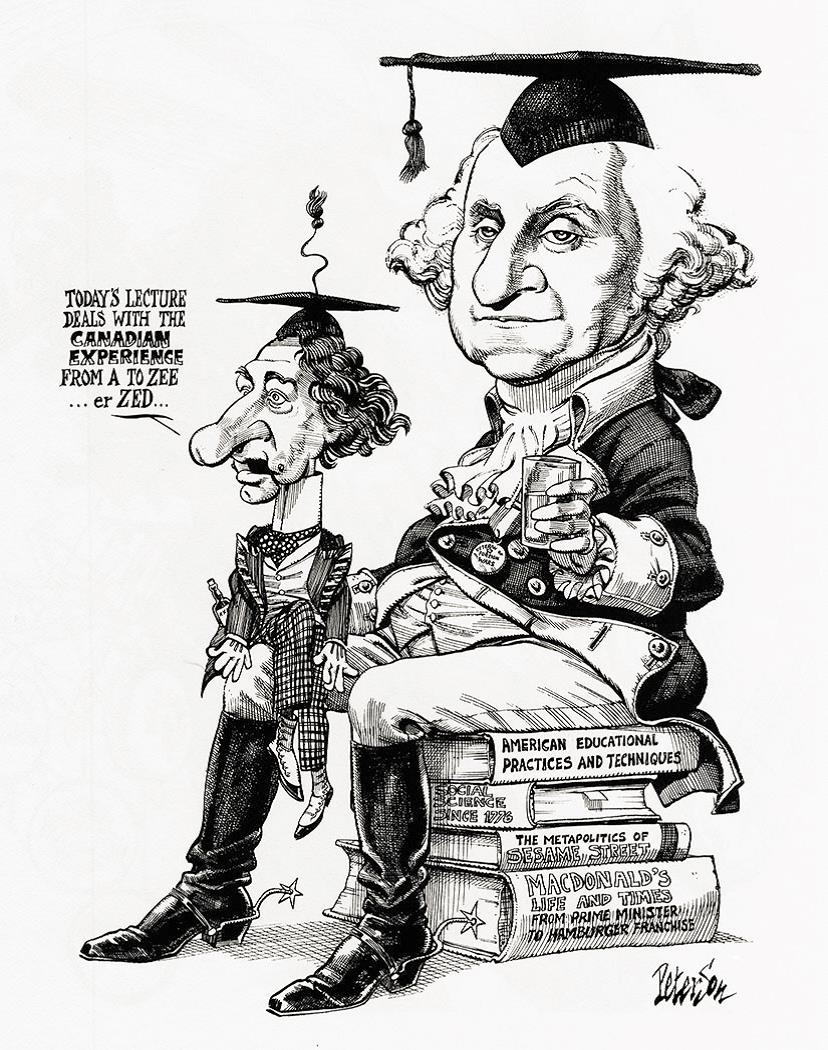
In this inventive cartoon, Roy Peterson of the Vancouver Sun portrayed our first prime minister delivering a lesson in Canadian matters to America’s first president, George Washington. This is something that Canadians are always attempting to do with our neighbours to the south.
Macdonald and Mackenzie: Scandalized!
John Wilson Bengough, originally a Toronto journalist, was Canada’s first important political cartoonist. His career paralleled the latter part of Macdonald's. In 1873, Bengough established a weekly humour publication in Toronto called Grip, named for the raven in Charles Dickens’s Barnaby Rudge.
The Conservative prime minister became the main target of Bengough’s barbs given that the cartoonist was a lifelong Liberal. Macdonald was a godsend to Bengough, what with his angular profile, ungainly figure, and intemperate habits. Mix this with the blatant corruption of 19th-century politics and you had the perfect recipe for some devastating cartoons.

The Pacific Scandal involved allegations of bribes taken by Conservative politicians from businessmen wanting to influence contracts for the building of a transcontinental railway between British Columbia and the eastern provinces. One Pacific Scandal cartoon by Bengough has Macdonald saying to Alexander Mackenzie, the leader of the opposition: “I admit I took the money and bribed the electors with it. Is there anything wrong about that?” The scandal led to the resignation of Macdonald, and a transfer of power to Mackenzie's Liberals.
Bengough would comment on Mackenzie (PM 1873-78) during the new prime minister's five years in power — but with little satiric enthusiasm. It was only with the re-election of Macdonald in 1878 that Grip regained its vigor and punch, hounding Macdonald until the end of his days in 1891.
Laurier and Borden: Rivals
All of his political life, Sir Robert Borden (PM 1911-20) carefully clipped cartoons about himself out of various newspapers. In 1926, he presented an album of these clippings to the National Archives in Ottawa. His choices are very interesting. Here is a Newt McConnell cartoon in the scrapbook, from a period when a bothersome Borden was the leader of the opposition to the government of Sir Wilfrid Laurier (PM 1896-1911).

McConnell was one of the most popular cartoonists of his day, working at the Toronto Daily News for 26 years. Although his style didn’t have the finesse of other cartoonists of the same period, he did have a lot more bite than Henri Julien and Sam Hunter.
Bennett: One-man show
R.B. Bennett (PM 1930-35) interrupted William Lyon Mackenzie King’s long reign as prime minister, serving from 1930 to 1935 during the Great Depression. Those were five bitter years for Canada, particularly in the West. Bennett was perceived to be pretty much a one-man show, disdainfully distant from the general population. When there were rumours that the prime minister would be reducing the size of his cabinet, Arch Dale made this suggestion in the following cartoon.
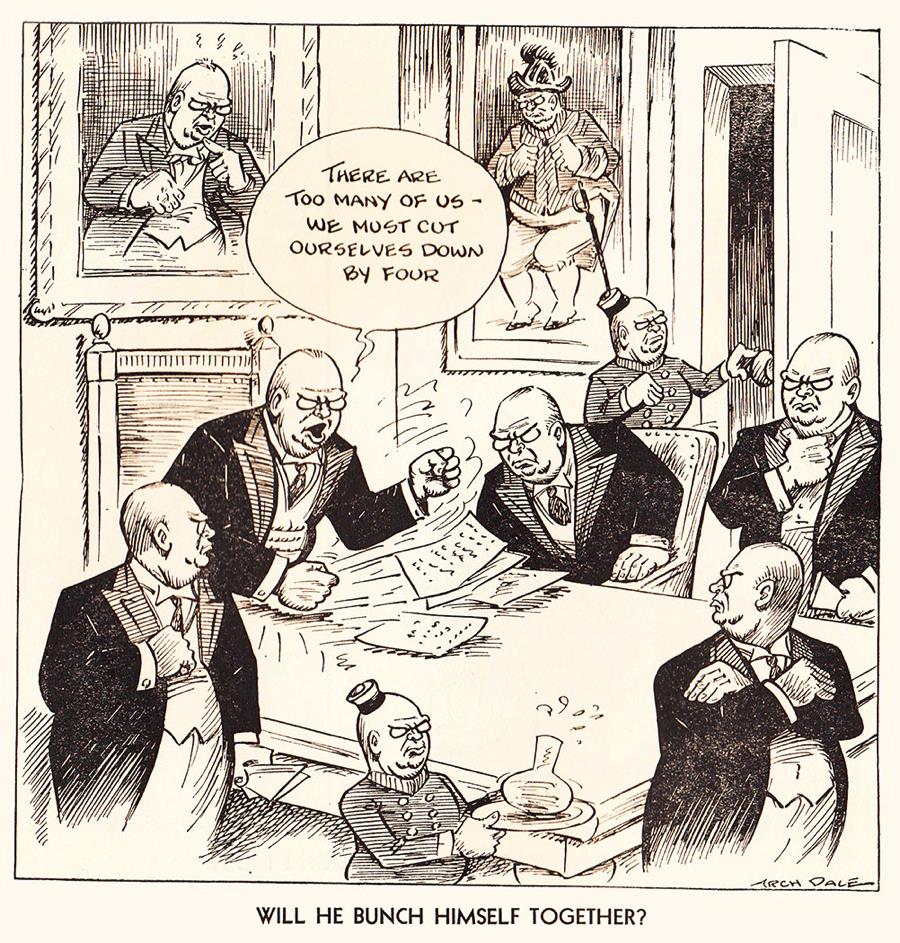
Mackenzie King: Survivor. Statesman.
Mackenzie King (PM 1921-26, 1926-30, 1935-48) returned as prime minister in 1935. In appearance, he was actually quite a bland individual. Cartoonists of his time therefore drew him in many different guises, depending on their opinion of the man. Here is a favourable caricature of Mackenzie King, portrayed as a world statesman by Robert LaPalme, who in the 1930s introduced an elegance and an economy of line that had never been seen in Canadian cartooning before. He used this avant-garde style to good effect in slashing attacks on the politicians of his day, particularly Québec Premier Maurice Duplessis. LaPalme occasionally drew federal politicians, but in a far more respectful manner.

St-Laurent: Talking to Americans
“Uncle Louis”— Louis St-Laurent (PM 1948-57)— seemed the perfect choice to govern Canada in those placid years of growth after the Second World War. However, during that prosperous period, Canadians became more aware of the importance of American money in their economy and American military strength in their mutual defence arrangements. But then, Americans are always on Canadian minds. In this National Newspaper Award–winning cartoon, St-Laurent is seen puzzling over the differences in our political arrangements.

Diefenbaker: The Chief
John Diefenbaker (PM 1957-63) won the election of 1957 with an upset minority victory. The following year his Progressive Conservatives were re-elected with the largest majority to that date in Canadian history. Diefenbaker certainly made himself heard, becoming an autocratic party chief and turning himself into a cartoonist’s dream. In the most famous cartoon of its day, Duncan Macpherson drew an arrogant Diefenbaker as Marie Antoinette saying: “Let them eat cake.”

Macpherson burst upon the scene as the editorial page cartoonist for the Toronto Star almost in tandem with Diefenbaker’s election. Throughout the Diefenbaker period, Macpherson created a body of work that rivaled that of what Bengough had done with Macdonald.
Pearson: Missions accomplished
Lester Pearson (PM 1963-68) defeated Diefenbaker in the 1963 federal election. However, he only managed to eke out a minority government – a situation he found himself in throughout his time as prime minister. It was hoped by many that Pearson could somehow clean up the mess that Diefenbaker had left behind. Ed McNally, the cartoonist for the Montreal Star, drew this tribute cartoon upon Pearson’s retirement in 1968, recognizing the prime minister’s accomplishments — carried out in a minority situation and under very trying circumstances.
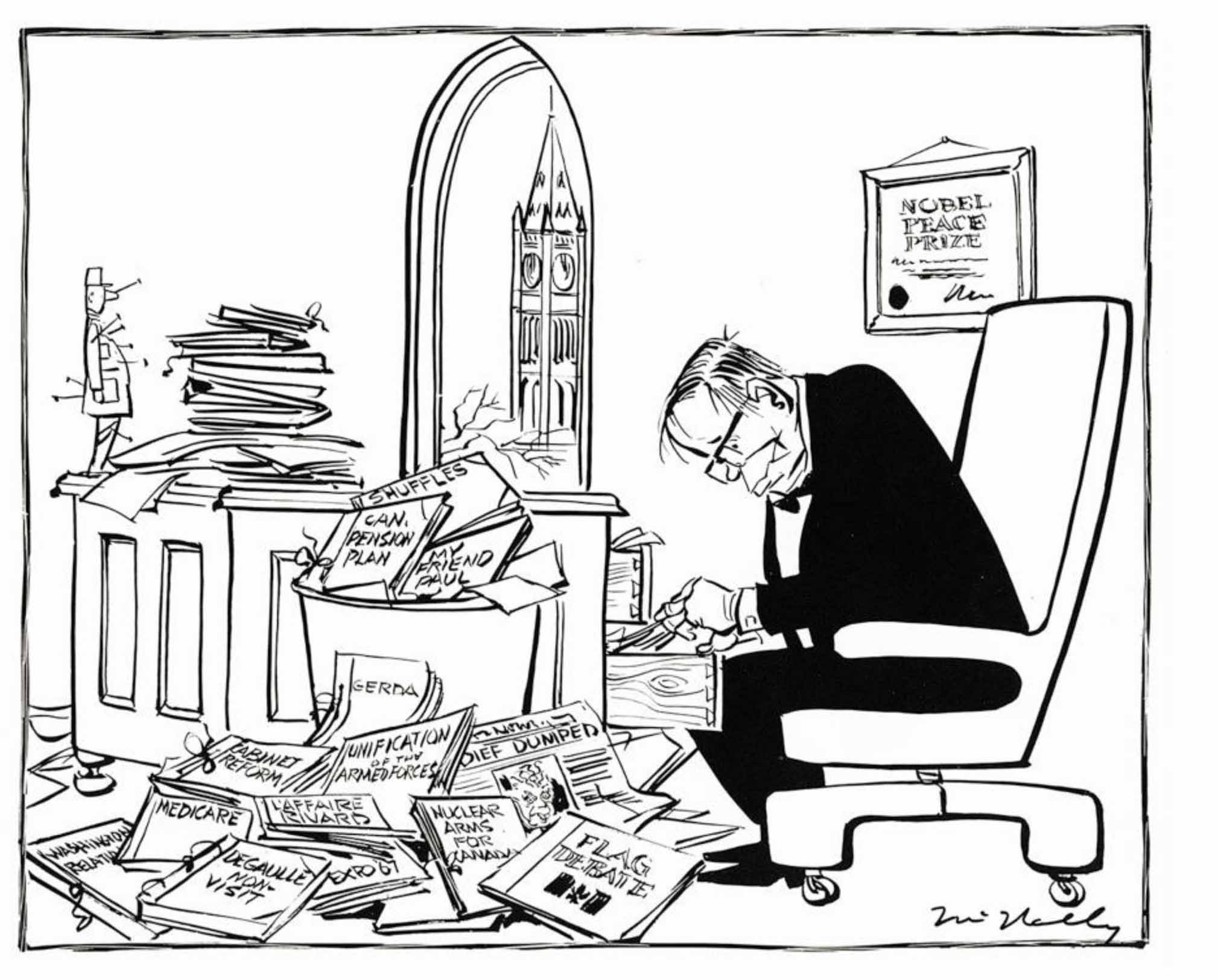
Trudeau: Northern dancer
In 1968, the election of Pierre Trudeau (PM 1968-79, 1980-84)sparked great enthusiasm, and Trudeaumania became the word of the day. Four years later, during the 1972 election campaign, Maclean’s magazine commissioned the Montreal cartoonist Aislin to draw Trudeau and Conservative opposition leader Robert Stanfield dancing. Maclean’s published the cartoon on an election booklet cover without realizing what Aislin had done with the knees.

Joe Clark (PM 1979-80)defeated Trudeau in June 1979, but only served as prime minister until March 1980, when his minority government was defeated on a motion of non-confidence. Trudeau then returned to power, as if only having had a brief respite.

Mulroney: Taking it on the chin
John Turner (PM 1984) became Liberal prime minister after the resignation of Pierre Trudeau in 1984. Turner immediately dissolved Parliament and called an election. But voters were tired of the same old Liberal team, and Turner was defeated by Brian Mulroney in a landslide.
Montreal Gazette cartoonist Aislin, working right in Brian Mulroney’s Québec backyard, delighted in poking fun at the future prime minister right from the start. During his leadership bid for the Progressive Conservative Party, Mulroney (PM 1984-93) would boast about the attractiveness of his chin. So Aislin put it in a bra — along with cleavage.
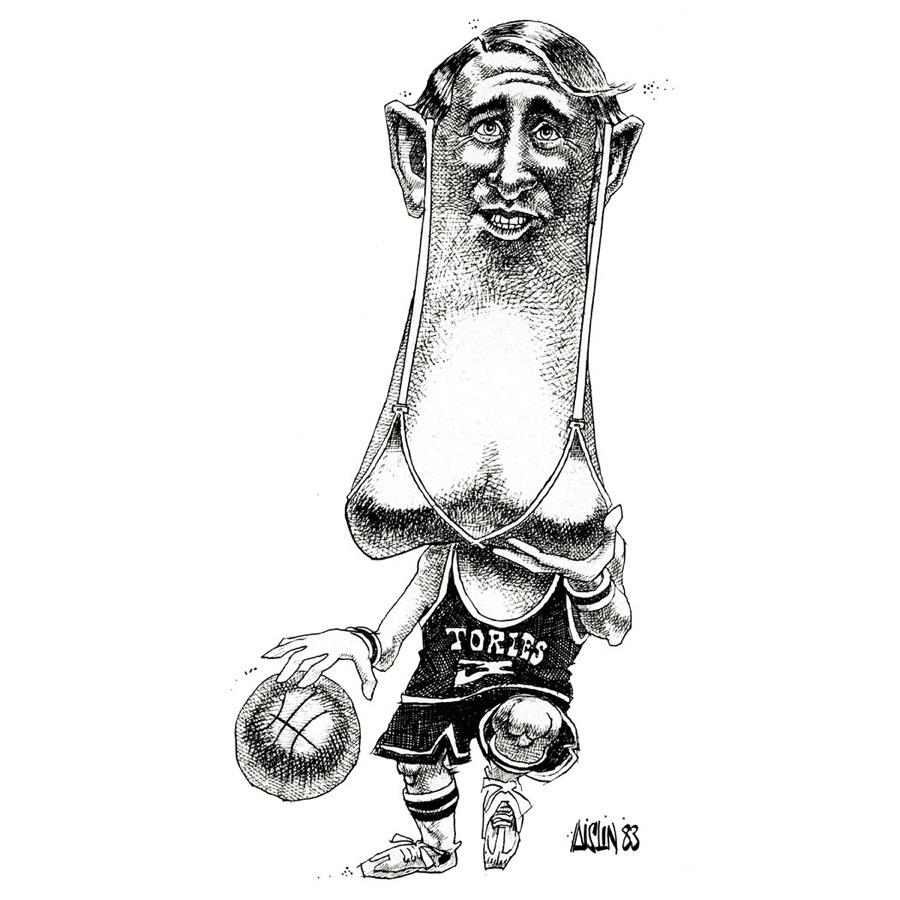
Obviously the longer a prime minister serves, the more cartoons will be drawn of him. We say “him,” because all of our prime ministers have been men with the exception of Kim Campbell (PM 1993). Campbell filled in as prime minister after the resignation of Mulroney in 1993 — but she only held office for 132 days. Trounced by Jean Chrétien’s Liberals in the 1993 election, Campbell’s Conservatives were reduced to two seats in Parliament.
Chrétien: Trust me
The average, beleaguered Canadian has always been a sympathetic character in Canadian political cartoons. Many representative symbols have been used, but none more so than the Canadian beaver, as with this nervous fellow below with Jean Chrétien (PM 1993-2003).

If our Canadian prime ministers have one thing in common, it is that almost all have had an issue or scandal that has followed them during their time in office. Chrétien created a "sponsorship program" in the province of Québec, to raise awareness of the Government of Canada's contributions to Québec. This resulted in the misuse of public funds intended for government advertising — and the subsequent calling of the Gomery Commission, which conducted a public inquiry into the matter.
Martin: In Chrétien's shadow
Paul Martin (PM 2003-06) wasn't implicated in the sponsorship scandal. But no matter how he tried, he could not escape the implications of the scandal on the Liberal Party. After Chrétien stepped down, the perceived sins of his predecessor followed Martin everywhere as Canada’s new prime minister. In this 2004 National Newspaper Award–winning cartoon, Theo Moudakis (a.k.a. Mou) captures Martin's frustrations.

Harper: Tory warrior
In the national spotlight, the scandal became a significant factor in the 2006 federal election when, after more than 12 years in power, the Liberals were defeated by the Conservatives, who formed a minority government led by Stephen Harper (PM 2006- ). Harper seemed a bland sort initially in comparison to his predecessors. But that has all changed, with the controversial issues of the day being reflected in the cartoons drawn of Harper to date.
It is hard to say if any cartoonist will emerge who owns Harper, as Bengough did with Macdonald or as Macpherson did with Diefenbaker. Here's one rendition of our current PM — with a little fun poked at his "helmet hair" — by Tony Jenkins of the Globe and Mail.
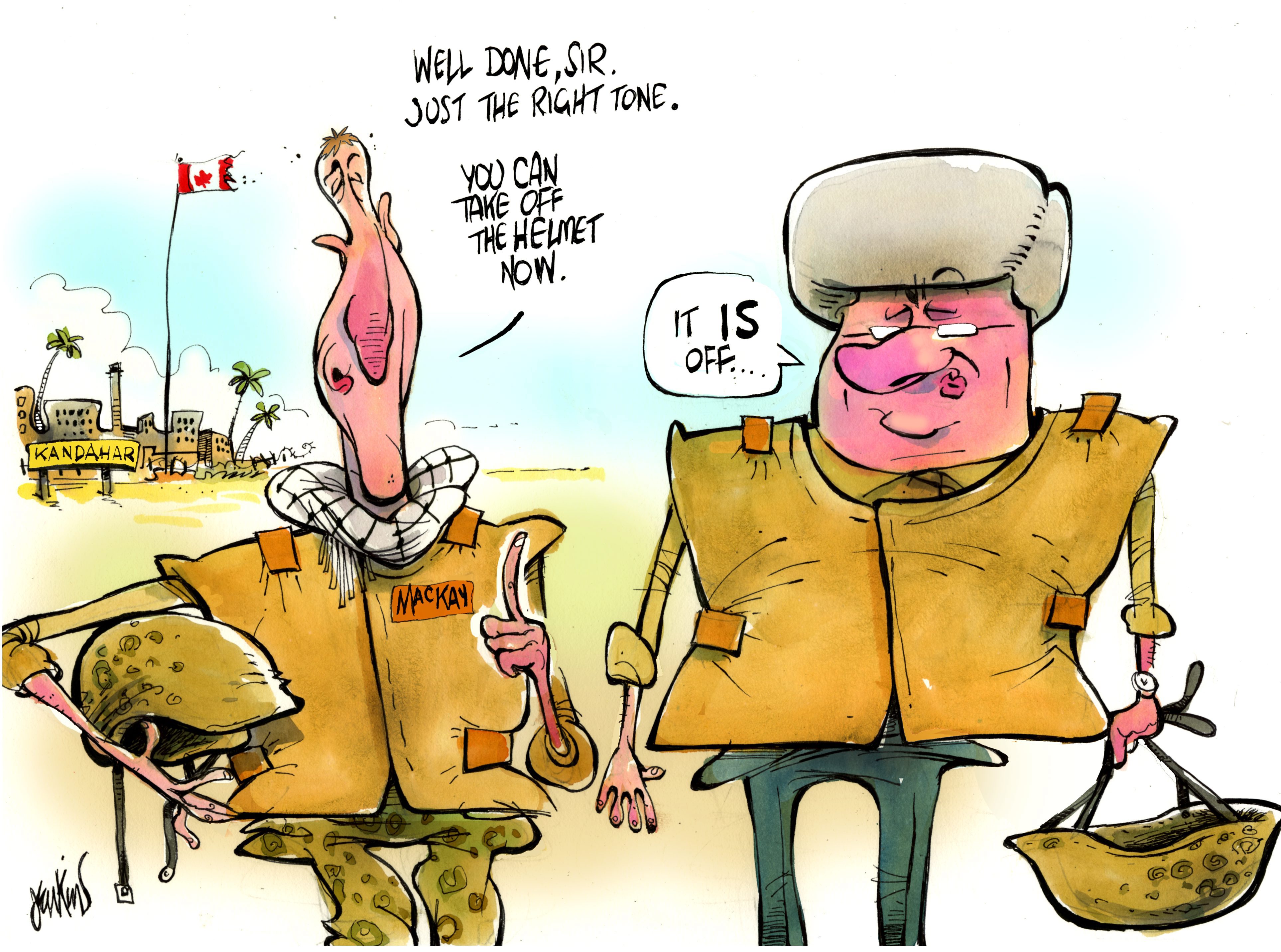

 Share on Facebook
Share on Facebook Share on X
Share on X Share by Email
Share by Email Share on Google Classroom
Share on Google Classroom

